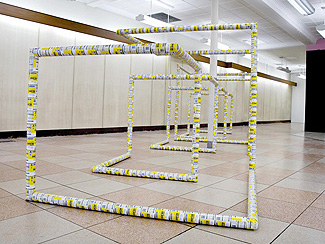Superabundant: A Celebration of Pattern Participating artists: Superabundant was an exhibition that created a sense of celebration, of joy and delight through the power of pattern. The exhibition featured work by nine artists who made use of pattern and decoration in very different ways, some adopting a systems approach to pattern whilst others were more fluid and organic. For this exhibition, many of the artists created new and sometimes site specific work especially for the Turner Contemporary Project Space. The use of decorative designs and patterns has always been central to the fine and applied arts from Roman mosaics and the intricate motifs of Islamic art to the innovative wallpaper and textiles of AWN Pugin and William Morris. In the twentieth century, excessive ornamentation was dismissed as decadent by the Modernist architects and designers of the Bauhaus: decoration for its own sake was replaced by abstraction and truth to materials. In this exhibition, the tension between decoration and abstraction was explored in Lesley Halliwell's intricate, large-scale Spirograph drawings and Daniel Sturgis' series of paintings with their vocabulary of colour, repetition and pattern. A number of works played directly with the external and internal surfaces of the Turner Contemporary Project Space, a former department store on Margate High Street: Richard Woods created a new decorative facade for the building while Jacqueline Poncelet installed a forest of pillars covered with a dizzying 'push-me-pull-you' motif. Architectural simulation of a different kind featured in Wim Delvoye's photograph of a marble floor created entirely out of salami. Jacob Dahlgren is fascinated by the surface of things and our everyday encounters with pattern and abstraction, from striped t-shirts photographed on the street to the curves that a stack of coloured plastic cups makes. Heaven is a place on earth was an installation made up of red, white and blue bathroom scales arranged on the floor like an interactive, modernist grid. Pattern is often associated with feelings of pleasure. Paul Moss' Danger Paintings however, with their disorientating zig-zags of red and white hazard tape, signaled an unspecified warning and functioned as both paintings and architectural screens. These paintings, like many of the works in the exhibition, were complex and labour intensive. Jim Drain's over the top, colourful sculptures made of wool, cloth and other found materials, combined a handmade aesthetic and an interest in non-Western traditions of art making with references to 60's Op art and psychedelia.
|
|
 |
 |
Turner Contemporary |
|